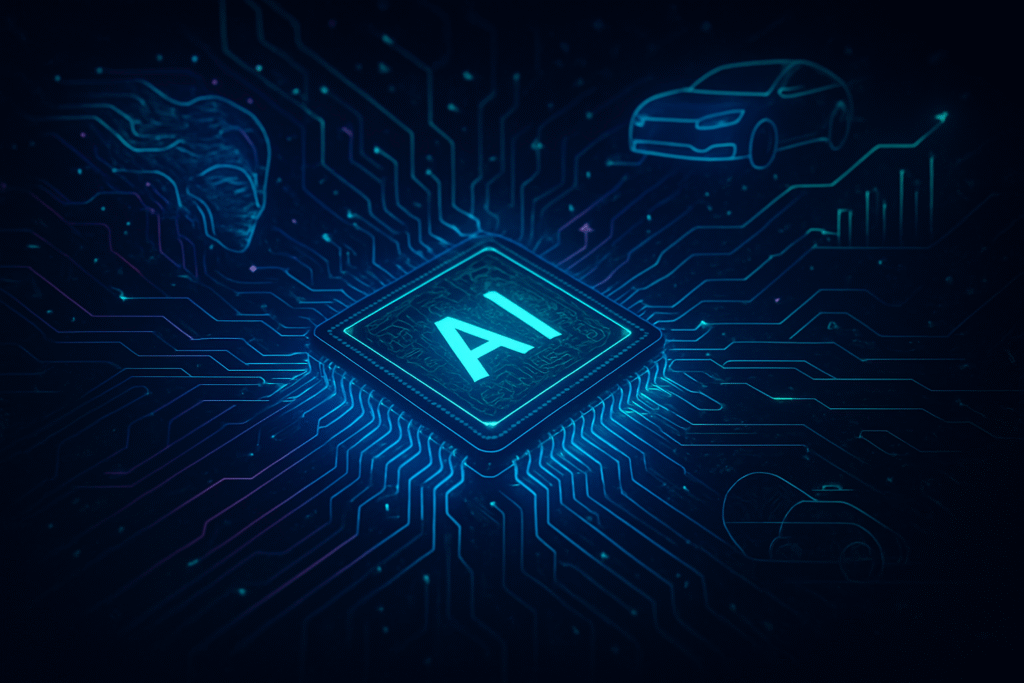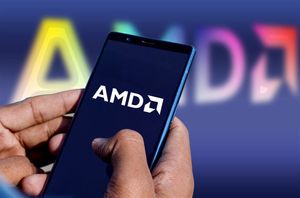
The global AI accelerator chip market is poised for an unprecedented surge, with projections indicating a staggering growth to US$283.13 billion by 2032. This monumental expansion, representing a compound annual growth rate (CAGR) of 33.19% from its US$28.59 billion valuation in 2024, underscores the foundational role of specialized silicon in the ongoing artificial intelligence revolution. The immediate significance of this forecast is profound, signaling a transformative era for the semiconductor industry and the broader tech landscape as companies scramble to meet the insatiable demand for the computational power required by advanced AI applications.
This explosive growth is primarily driven by the relentless advancement and widespread adoption of generative AI, the increasing sophistication of natural language processing (NLP), and the burgeoning field of autonomous systems. These cutting-edge AI domains demand specialized hardware capable of processing vast datasets and executing complex algorithms with unparalleled speed and efficiency, far beyond the capabilities of general-purpose processors. As AI continues to permeate every facet of technology and society, the specialized chips powering these innovations are becoming the bedrock of modern technological progress, reshaping global supply chains and solidifying the semiconductor sector as a critical enabler of future-forward solutions.
The Silicon Brains Behind the AI Revolution: Technical Prowess and Divergence
The projected explosion in the AI accelerator chip market is intrinsically linked to the distinct technical capabilities these specialized processors offer, setting them apart from traditional CPUs and even general-purpose GPUs. At the heart of this revolution are architectures meticulously designed for the parallel processing demands of machine learning and deep learning workloads. Generative AI, for instance, particularly large language models (LLMs) like ChatGPT and Gemini, requires immense computational resources for both training and inference. Training LLMs involves processing petabytes of data, demanding thousands of interconnected accelerators working in concert, while inference requires efficient, low-latency processing to deliver real-time responses.
These AI accelerators come in various forms, including Graphics Processing Units (GPUs), Application-Specific Integrated Circuits (ASICs), Field-Programmable Gate Arrays (FPGAs), and neuromorphic chips. GPUs, particularly those from NVIDIA (NASDAQ: NVDA), have dominated the market, especially for large-scale training models, due to their highly parallelizable architecture. However, ASICs, exemplified by Google's (NASDAQ: GOOGL) Tensor Processing Units (TPUs) and Amazon's (NASDAQ: AMZN) Inferentia, are gaining significant traction, particularly within hyperscalers, for their optimized performance and energy efficiency for specific AI tasks. These ASICs offer superior performance per watt for their intended applications, reducing operational costs for large data centers.
The fundamental difference lies in their design philosophy. While CPUs are designed for sequential processing and general-purpose tasks, and general-purpose GPUs excel in parallel graphics rendering, AI accelerators are custom-built to accelerate matrix multiplications and convolutions – the mathematical backbone of neural networks. This specialization allows them to perform AI computations orders of magnitude faster and more efficiently. The AI research community and industry experts have universally embraced these specialized chips, recognizing them as indispensable for pushing the boundaries of AI. Initial reactions have highlighted the critical need for continuous innovation in chip design and manufacturing to keep pace with AI's exponential growth, leading to intense competition and rapid development cycles among semiconductor giants and innovative startups alike. The integration of AI accelerators into broader system-on-chip (SoC) designs is also becoming more common, further enhancing their efficiency and versatility across diverse applications.
Reshaping the Competitive Landscape: Beneficiaries and Disruptors
The anticipated growth of the AI accelerator chip market is poised to profoundly reshape the competitive dynamics across the tech industry, creating clear beneficiaries, intensifying rivalries, and potentially disrupting existing product ecosystems. Leading semiconductor companies like NVIDIA (NASDAQ: NVDA) stand to gain immensely, having established an early and dominant position in the AI hardware space with their powerful GPU architectures. Their CUDA platform has become the de facto standard for AI development, creating a significant ecosystem lock-in. Similarly, Advanced Micro Devices (AMD) (NASDAQ: AMD) is aggressively expanding its MI series accelerators, positioning itself as a strong challenger, as evidenced by strategic partnerships such as OpenAI's reported commitment to significant chip purchases from AMD. Intel (NASDAQ: INTC), while facing stiff competition, is also investing heavily in its AI accelerator portfolio, including Gaudi and Arctic Sound-M chips, aiming to capture a share of this burgeoning market.
Beyond these traditional chipmakers, tech giants with vast cloud infrastructures are increasingly developing their own custom silicon to optimize performance and reduce reliance on external vendors. Google's (NASDAQ: GOOGL) TPUs, Amazon's (NASDAQ: AMZN) Trainium and Inferentia, and Microsoft's (NASDAQ: MSFT) Maia AI accelerator are prime examples of this trend. This in-house chip development strategy offers these companies a strategic advantage, allowing them to tailor hardware precisely to their software stacks and specific AI workloads, potentially leading to superior performance and cost efficiencies within their ecosystems. This move by hyperscalers represents a significant competitive implication, as it could temper the growth of third-party chip sales to these major customers while simultaneously driving innovation in specialized ASIC design.
Startups focusing on novel AI accelerator architectures, such as neuromorphic computing or photonics-based chips, also stand to benefit from increased investment and demand for diverse solutions. These companies could carve out niche markets or even challenge established players with disruptive technologies that offer significant leaps in efficiency or performance for particular AI paradigms. The market's expansion will also fuel innovation in ancillary sectors, including advanced packaging, cooling solutions, and specialized software stacks, creating opportunities for a broader array of companies. The competitive landscape will be characterized by a relentless pursuit of performance, energy efficiency, and cost-effectiveness, with strategic partnerships and mergers becoming commonplace as companies seek to consolidate expertise and market share.
The Broader Tapestry of AI: Impacts, Concerns, and Milestones
The projected explosion of the AI accelerator chip market is not merely a financial forecast; it represents a critical inflection point in the broader AI landscape, signaling a fundamental shift in how artificial intelligence is developed and deployed. This growth trajectory fits squarely within the overarching trend of AI moving from research labs to pervasive real-world applications. The sheer demand for specialized hardware underscores the increasing complexity and computational intensity of modern AI, particularly with the rise of foundation models and multimodal AI systems. It signifies that AI is no longer a niche technology but a core component of digital infrastructure, requiring dedicated, high-performance processing units.
The impacts of this growth are far-reaching. Economically, it will bolster the semiconductor industry, creating jobs, fostering innovation, and driving significant capital investment. Technologically, it enables breakthroughs that were previously impossible, accelerating progress in fields like drug discovery, climate modeling, and personalized medicine. Societally, more powerful and efficient AI chips will facilitate the deployment of more intelligent and responsive AI systems across various sectors, from smart cities to advanced robotics. However, this rapid expansion also brings potential concerns. The immense energy consumption of large-scale AI training, heavily reliant on these powerful chips, raises environmental questions and necessitates a focus on energy-efficient designs. Furthermore, the concentration of advanced chip manufacturing in a few regions presents geopolitical risks and supply chain vulnerabilities, as highlighted by recent global events.
Comparing this moment to previous AI milestones, the current acceleration in chip demand is analogous to the shift from general-purpose computing to specialized graphics processing for gaming and scientific visualization, which laid the groundwork for modern GPU computing. However, the current AI-driven demand is arguably more transformative, as it underpins the very intelligence of future systems. It mirrors the early days of the internet boom, where infrastructure build-out was paramount, but with the added complexity of highly specialized and rapidly evolving hardware. The race for AI supremacy is now inextricably linked to the race for silicon dominance, marking a new era where hardware innovation is as critical as algorithmic breakthroughs.
The Road Ahead: Future Developments and Uncharted Territories
Looking to the horizon, the trajectory of the AI accelerator chip market promises a future brimming with innovation, new applications, and evolving challenges. In the near term, we can expect continued advancements in existing architectures, with companies pushing the boundaries of transistor density, interconnect speeds, and packaging technologies. The integration of AI accelerators directly into System-on-Chips (SoCs) for edge devices will become more prevalent, enabling powerful AI capabilities on smartphones, IoT devices, and autonomous vehicles without constant cloud connectivity. This will drive the proliferation of "AI-enabled PCs" and other smart devices capable of local AI inference.
Long-term developments are likely to include the maturation of entirely new computing paradigms. Neuromorphic computing, which seeks to mimic the structure and function of the human brain, holds the promise of ultra-efficient AI processing, particularly for sparse and event-driven data. Quantum computing, while still in its nascent stages, could eventually offer exponential speedups for certain AI algorithms, though its widespread application is still decades away. Photonics-based chips, utilizing light instead of electrons, are also an area of active research, potentially offering unprecedented speeds and energy efficiency.
The potential applications and use cases on the horizon are vast and transformative. We can anticipate highly personalized AI assistants that understand context and nuance, advanced robotic systems capable of complex reasoning and dexterity, and AI-powered scientific discovery tools that accelerate breakthroughs in materials science, medicine, and energy. Challenges, however, remain significant. The escalating costs of chip design and manufacturing, the need for robust and secure supply chains, and the imperative to develop more energy-efficient architectures to mitigate environmental impact are paramount. Furthermore, the development of software ecosystems that can fully leverage these diverse hardware platforms will be crucial. Experts predict a future where AI hardware becomes increasingly specialized, with a diverse ecosystem of chips optimized for specific tasks, from ultra-low-power edge inference to massive cloud-based training, leading to a more heterogeneous and powerful AI infrastructure.
A New Era of Intelligence: The Silicon Foundation of Tomorrow
The projected growth of the AI accelerator chip market to US$283.13 billion by 2032 represents far more than a mere market expansion; it signifies the establishment of a robust, specialized hardware foundation upon which the next generation of artificial intelligence will be built. The key takeaways are clear: generative AI, autonomous systems, and advanced NLP are the primary engines of this growth, demanding unprecedented computational power. This demand is driving intense innovation among semiconductor giants and hyperscalers, leading to a diverse array of specialized chips designed for efficiency and performance.
This development holds immense significance in AI history, marking a definitive shift towards hardware-software co-design as a critical factor in AI progress. It underscores that algorithmic breakthroughs alone are insufficient; they must be coupled with powerful, purpose-built silicon to unlock their full potential. The long-term impact will be a world increasingly infused with intelligent systems, from hyper-personalized digital experiences to fully autonomous physical agents, fundamentally altering industries and daily life.
As we move forward, the coming weeks and months will be crucial for observing how major players like NVIDIA (NASDAQ: NVDA), AMD (NASDAQ: AMD), and Intel (NASDAQ: INTC) continue to innovate and compete. We should also watch for further strategic partnerships between chip manufacturers and leading AI labs, as well as the continued development of custom AI silicon by tech giants such as Google (NASDAQ: GOOGL), Amazon (NASDAQ: AMZN), and Microsoft (NASDAQ: MSFT). The evolution of energy-efficient designs and advancements in manufacturing processes will also be critical indicators of the market's trajectory and its ability to address growing environmental concerns. The future of AI is being forged in silicon, and the rapid expansion of this market is a testament to the transformative power of artificial intelligence.
This content is intended for informational purposes only and represents analysis of current AI developments.
TokenRing AI delivers enterprise-grade solutions for multi-agent AI workflow orchestration, AI-powered development tools, and seamless remote collaboration platforms.
For more information, visit https://www.tokenring.ai/.


















